Police Brutality Lawsuit Against Scottsdale Officer Underway
Police Brutality Lawsuit Against Scottsdale Officer Underway
Just last week, the City of Scottsdale filed an answer to a lawsuit our police excessive force lawyers filed. The lawsuit was filed against one of the City’s police officers and alleges that the officer used excessive force against our client. Specifically, the lawsuit alleges that the officer used excessive force against our client for exercising free speech.
The lawsuit was filed in the United States District Court of Arizona. The lawsuit is entitled Patel v. Vattuone and was designated case #CV-22-01852. The case is pending before the honorable Michael T. Morrisey.
The Circumstances Surrounding the Excessive Force Case
In the fall of 2021, the client visited Scottsdale with friends from the east coast for his bachelor party. The group went out for dinner and drinks and eventually found themselves at Casa Amigos a bar and restaurant in Old Town Scottsdale. Shortly after midnight, they were approached by City of Scottsdale police officer Dominique Vattuone. The officer told the client that security at the establishment needed his group to leave because of accusations made by another patron against their group.
After paying his bar tab, the client continued to question the officer as to why he did not investigate the unfounded complaint made by another patron. The client felt it was unfair that he was being forced to leave when he did nothing wrong. The client was intoxicated and animated when speaking to the officer. As the client raised his voice to the officer, the officer decided he had enough.
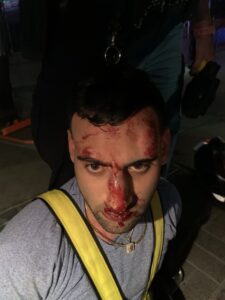
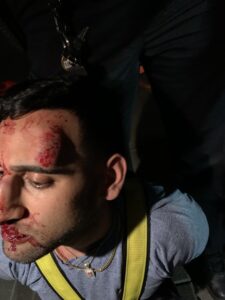
The officer went hands on and grabbed the client by the wrists and kneed him in the midsection area. The officer then took the client to the ground and punched him in the head and tasered him. In doing so, the officer caused significant injuries including breaking the client’s nose. The client was left bloodied and battered.
Additional Details Regarding the Use of Force
There were several other officers at the scene and the level of force used was unnecessary. The only thing the client was guilty of was being visibly intoxicated and loudly voicing his opinion. At worst, he was guilty of being obnoxious and a bad drunk. Had the officer had enough of him, he could have arrested him for disorderly conduct or drunk in public. The officer could have done so without using any force.
However, the officer’s use of force was in response to the client voicing his opinion, obnoxiously or not, and was completely unnecessary. The officer could have told him he was under arrest and ordered him to turn around and put his hands behind his back. This would be consistent with the officer’s training which teaches him to de-escalate situations and to only use the amount of force necessary under the circumstances. The officer snapped and lost his temper. He went “hands on” eventually leaving the client with a displaced nasal bone fracture and hematoma on his forehead.
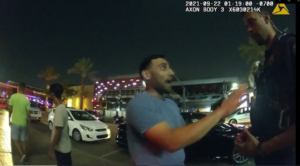
The Training Arizona Police Officers Are Provided On Use of Force
The Arizona Peace Officer Standards and Training (AZPOST) Board sets forth the training that Arizona law enforcement officers are to follow and abide by. The training that Arizona law enforcement officers receive is set forth in AZPOST lesson plans. Two of those lesson plans are of particular importance. They are entitled “Arizona Law on Use of Force Encounters” and “Dynamics of Use of Force Encounters.”
These Lesson Plans can be found on Arizona POST’s website at post.az.gov. The lesson plans on use of force discuss when it is permissible to use force. These lesson plans set forth when the use of force can be considered a constitutional violation. These lesson plans also set forth case law which instructs what factors are to be considered when using force.
What Factors Are Police Supposed to Consider When Using Force in Arizona?
When using force in Arizona, police officers are taught to follow the Supreme Court case of Graham v. Connor. This case is the seminal case on the use of force. Graham v. Connor holds that the use of force is to be judged by an objectively reasonable standard. In other words, whether or not another reasonable officer in the same position would have used that amount of force or believed it was necessary under the same circumstances.
In Graham v. Connor, the United States Supreme Court ruled there is no “precise or mechanical” application to test reasonableness. Instead, every situation is different and all facts must be analyzed on a case by case basis. However, the Court did set forth three major factors an officer should consider in determining the amount of force used.
- The severity of the crime
- Whether the individual poses an immediate threat to officer safety or the safety of the public
- Whether the individual is actively resisting or trying to escape
The Force Used by the Police Officer Against the Client Was Not Justified
In the case discussed above, the three major factors did not warrant the use of force the officer used. The severity of the crime the client committed was minimal. The client was acting disorderly and drunk in public. He had not committed a serious felony or violent crime.
Next, the client did not pose an immediate threat to the officer or the public. The client was not a danger to anyone at the time. There were multiple officers on the scene. The client had already been searched and was unarmed. The client was much smaller than Officer Vattuone and was in a place where he could easily be detained and arrested.
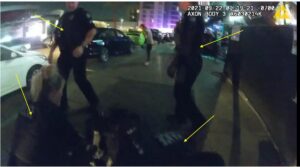
Finally, the client was not actively resisting or trying to escape. Active resistance can be categorized as when an individual fights back or uses some sort of physical resistance when being arrested. This could include pulling away from an officer’s grasp, striking or pushing an officer, etc. The client did not do anything like that before force was used. He was also not trying to escape. Notably, Officer Vattuone wrote in his police report that the client was passively resisting.
Passive resistance is the opposite of active resistance. This includes acts that involve refusing to follow an officer’s commands. For example, refusing to exit a vehicle when ordered to do so or to sit down when instructed.
The Specific Allegations Set forth in the Police Brutality Lawsuit
Below are the verbatim allegations our police excessive force attorneys set forth in the lawsuit:
- On September 22, 2021, Patel was attending his bachelor party with three of his friends at Casa Amigos in the Entertainment District of Old Town in Scottsdale, Arizona.
- Shortly after midnight, a patron accused one of Patel’s friends of doing something he did not do. As a result, a Casa Amigos security member escorted Patel out the front door of the establishment.
- At approximately 1:00 a.m., the Casa Amigos security member summoned Officer Vattuone as Vattuone was driving in the area. The security member informed Vattuone that a patron had made an accusation against Patel’s group.
- Vattuone communicated the accusation to Patel and conducted a search of his person. The investigation showed the accusation to be unfounded.
- Shortly after, Vattuone informed Patel that he needed to pay his tab and leave the premises.
- Patel was upset that he and his friends were being forced to leave Casa Amigos during his bachelor party based on a false accusation. Patel suggested to Vattuone that Vattuone should review the security video footage and that the patron who had made the false report should be arrested.
- After paying his bar tab, Patel continued to question Vattuone outside Casa Amigos about why Patel was the one paying the consequences for the false accusation. Patel also suggested to Vattuone that Vattuone was talking to him in a demeaning or patronizing tone. Patel claimed that Vattuone was not speaking in his “actual” voice.
- In response, Vattuone seized Patel by the wrists, delivered a knee strike to his body, and drove him backwards toward a chain link fence. Vattuone spun Patel around, placed his arm around Patel’s neck and pushed him face first into the fence. Then, Vattuone slammed Patel to the pavement where Vattuone delivered knee and fist strikes to Patel’s body and head and tased Patel in drive-stun mode. In the process, Vattuone caused Patel to suffer a left frontal scalp hematoma and a displaced nasal bone fracture.
- At the time Vattuone went hands-on with Patel, no fewer than five to seven additional Scottsdale police officers were present at the scene and Patel had already been searched for weapons and contraband.
- Patel was taken by ambulance to HonorHealth Scottsdale Osborn Medical Center for treatment for his injuries.
- At no time did Patel attempt to flee the scene, evade arrest, or engage in active resistance of his arrest.
- All charges against Patel arising from the incident were dismissed.
The Fourth Amendment Claim for Excessive Force
Our Arizona civil rights lawyers included a Fourth Amendment excessive force claim in the lawsuit. The Fourth Amendment protects citizens from illegal search and seizure by law enforcement officers. This includes local law enforcement officers such as Arizona Department of Public Safety officers, County Sheriff Offices and their deputy sheriffs, and city and town police.
The use of unconstitutional or illegal force is considered a seizure of the person under the law.
Although the Fourth Amendment speaks to illegal search and seizure, it still guarantees an individual the right to be free from excessive force. The use of unconstitutional or illegal force is considered a seizure of the person under the law. It is not an actual seizure of goods or items as most people would typically think of. The best way to think of this is to consider the illegal use of force by law enforcement as a seizure of someone’s right to be free from unreasonable force.
The First Amendment Claim for Retaliation for Using Free Speech
Most people know that the First Amendment guarantees freedom of speech. This also includes freedom of expression. For example, people are allowed to protest and express their views without arrest by law enforcement for doing so. This right is well-established and guaranteed by the Constitution and the First Amendment to the Constitution.
Freedom of speech includes more than just protesting the government. It also includes the right of an individual to express their opinions to law enforcement. It also includes the right of an individual to question a police officer.
The Right to Question Police is Well Established in Case Law
The right to question police is protected First Amendment Speech. This is set forth in controlling case law. In the United States Supreme Court Case of City of Houston v. Hill, the court set forth:
“[t]he First Amendment protects a significant amount of verbal criticism and challenge directed at police officers….[while an individual’s statements to police may be] provocative and challenging, they are nevertheless protected against censorship or punishment, unless shown likely to produce a clear and present danger of a serious substantive evil that rises far above public inconvenience, annoyance, or unrest…. [t]he freedom of individuals verbally to oppose or challenge police action without thereby risking arrest is one of the principal characteristics by which we distinguish a free nation from a police state.
As a result, if Officer Vattuone used force against the client solely because of how the client spoke to him, it would be considered a violation of the client’s First Amendment rights. That is what our civil rights attorneys intend to prove in the lawsuit.
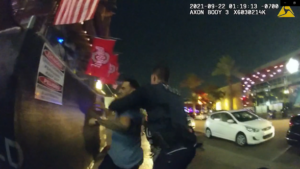
Contact Our Arizona Police Brutality Lawyers to Discuss Your Case
If you or a loved one has experienced police brutality or other law enforcement misconduct, contact our office today. Our Scottsdale civil rights lawyers specialize in excessive force and police brutality cases. We have prevailed on these cases and regularly handle them throughout Arizona including Maricopa County. We have handled high-profile matters involving serious injuries and wrongful death due to the acts of law enforcement. A consultation is free. If we take your case you owe nothing unless we prevail.
About the author: The content on this page was provided by Scottsdale personal injury attorney and Arizona civil rights lawyer Tony Piccuta. Piccuta graduated with honors from Indiana University-Maurer School of Law in Bloomington, Indiana (Previously Ranked Top 35 US News & World Report). Piccuta took and passed the State bars of Arizona, California, Illinois and Nevada (all on the first try). He actively practices throughout Arizona and California. He is a trial attorney that regularly handles serious personal injury cases and civil rights lawsuits. He has obtained six and seven figure verdicts in both state and federal court. He has been recognized by Super Lawyers for six years straight. He is a member of the Arizona Association of Justice, Maricopa County Bar Association, Scottsdale Bar Association, American Association for Justice, National Police Accountability Project and Consumer Attorneys of California, among other organizations.
Disclaimer: The information on this web site is for informational purposes only and does not constitute legal advice. The information on this page is attorney advertising. Reading and relying upon the content on this page does not create an attorney-client relationship. If you are seeking legal advice, you should contact our law firm for a free consultation and to discuss your specific case and issues.
References:
[2] https://post.az.gov/sites/default/files/2022-01/Dynamics%20of%20Use%20of%20Force%20Encounters.pdf

